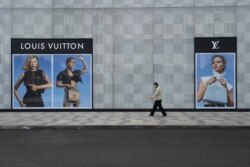China said Monday it boasts $182 trillion in total national assets, which it hopes will provide enough support to lift its economy out of contraction by boosting domestic consumption after the coronavirus outbreak is contained.
But analysts say local consumers, who have been holding out because of lockdown policies and concerns about finances, are unlikely to go on a shopping spree to make up for lost time.
Declining income?
“To some extent, everyone’s wealth [income] would be affected by the COVID-19 pandemic. So, as a whole, it is almost impossible to have a wealth effect to bolster [China’s] domestic consumption,” Liang Kuo-yuan, president of Polaris Research Institute in Taipei, told VOA.
China is the world’s second-biggest economy.
Ning Jizhe is vice chairman of China’s National Development and Reform Commission (NDRC). He said at a news conference Monday that domestic consumption has recovered and has seen an 8.3% increase in April from March, although it still posted a 7.5% decline compared with the same period last year.
Ning said he expects the improvement to be stronger in May although no catch-up spending is in sight. He added that the Chinese government has kicked off measures to boost spending in the commodity and service sectors.
China has also pledged to build up 5G networks and internet connections as a way to encourage both e-commerce and spending on organic agricultural products, the official said.
Economic stimulus
According to Ning, China plans to raise $140 billion through the issuance of national treasury bills and $526 billion in local government bonds to stimulate the economy.
Calling China’s statistics opaque, Liang said that household spending on daily necessities will provide a bit of a boost to domestic consumption.
But any major spending by consumers, even among those with substantial resources, likely will not be aggressive, he argued.
Given its heavy debt burden, especially those hidden in its shadow banking system, China won't be able to substantially increase government expenditure to revive its economy as it did during the 2008 financial crisis, according to Liang.
Liao Qun, chief economist at Hong Kong-based China CITIC Bank International Ltd, said he did not agree with the premise that China has a high debt burden.
But he agreed that, despite their high rate of savings, consumers will not increase their spending before lockdown policies are completely lifted. He said China’s debt ratio is under 60% of its gross domestic product, or GDP.
Consumption growth
Liao said domestic consumption accounts for about 55% of China’s GDP with private consumption accounting for 40% and government expenditures making up the balance.
Liao said the potential exists for consumption to increase if incomes from China’s manufacturing-oriented economy remain stable.
Economists are divided over whether the Chinese economy will weather the virus-inflicted downturn. Questions arose after Chinese Premier Li Keqiang failed to set an economic growth target for 2020 when he addressed the much-delayed National People’s Congress on Friday. The last time China failed to set a target was in 2002.
Before China’s economy contracted 6.8% in the first quarter from a year ago, the Communist leadership, which often relies on economic growth for its ruling legitimacy, had projected a 5.6% growth goal for this year.
Liang said that China’s economic outlook is unclear with authorities giving mixed signals.
W-shaped recovery
Even if the Chinese economy rebounds, at best, it will be a W-shaped recovery, Liang said, referring to cycles in which the economy goes into recession ahead of full recovery.
And challenges remain for China to address the economic fallout from the global pandemic. China watchers say growing anti-China sentiment and other issues may prompt some governments to reduce their economic dependence on Beijing and accelerate their exit from the Chinese market.
But Liao said he doubts the business migration trend will hurt the fundamentals of the Chinese economy. He said the trend began a decade ago when foreign businesses moved their assembly lines to neighboring Asian countries for cheaper labor and land.
During the same period, China’s exports continued to grow. He said they accounted for 13% of the world’s total exports in 2019, up from 9% a decade ago.
“If it is a political calculation, everyone will suffer from the economic point of view. No one knows for sure if such a [political] move will be made. But in terms of economic [competitiveness], industries in China are still the cheapest, the most efficient and attractive” to foreign investors, Liao said.











